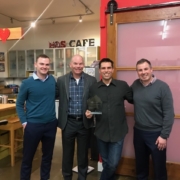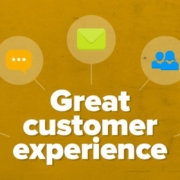The 20 Most Important Legal Technology Developments of 2018
What a whirlwind of a year it has been for legal technology. Barely a week into 2018, industry-changing news broke of Avvo’s sale to Internet Brands. Legal tech news has been nonstop ever since – so much that it’s a struggle to keep up with it all.
For several years now, I’ve closed out the year with a round-up of the 10 most important legal developments (2016, 2015, 2014, 2013). Last year, I bypassed the top 10 to focus on a single overarching development, The Year of Women in Legal Tech.
This year, a top-10 list won’t suffice. So much of significance has happened that I can’t sum it all up in just 10 points. Instead, I’m doubling the list to offer my top 20 picks for the year’s most important legal technology developments.
As in past years, the order in which I list these is not meant to be a ranking by importance. They are all important, each in their own way.
 1. Analytics become essential.
1. Analytics become essential.
If you were to judge the year’s most important legal technology by looking at conference agendas and media coverage, you’d probably say it was the continuing development of artificial intelligence. But if you judge the most important technology by its direct impact on the practice of law, then it would have to be analytics. As I suggested in a recent column, we could be nearing the point where it would be malpractice for a lawyer not to use analytics.
At the center of the analytics story this year has been LexisNexis. Following its acquisitions of Lex Machina in 2015 and Ravel Law, it has been steadily working to build on the foundations established by those products and integrate them into its legal research platform Lexis Advance. It has steadily expanded the practice areas covered by Lex Machina’s analytics, and from Ravel it added both visual search results and the unique Context analytics that examine the language of judges’ opinions. The defining moment for LexisNexis this year came in July, when it put a stake in the ground to claim the analytics space.
But LexisNexis was by no means the only legal analytics story this year. Thomson Reuters also put down its claim with the launch of its next-generation research platform Westlaw Edge, which for the first time brought detailed docket analytics to the Westlaw research platform. Elsewhere in the legal world, Fastcase released its Analytics Workbench, which it said would allow legal professionals to build their own bespoke litigation analytics, and judicial analytics company Gavelytics got new funding and expanded the scope of its coverage.
 2. Legal tech goes global.
2. Legal tech goes global.
Legal tech has long been provincial in its perspective. Here in the U.S., we’ve tended to focus on what was happening here in the U.S., ignoring and therefore ignorant of legal tech developments elsewhere in the world. But this year, that changed dramatically. The world of legal tech got flatter. That was largely thanks to the Global Legal Hackathon.
This audacious effort by organizers who had never before run even a local hackathon turned out to be a huge success. They rallied participation by 600-1,000 teams in 40 cities and 22 countries around the world. During the hackathon, they dispatched Dera Nevin as their own “global ambassador for legal technology,” who visited 19 destinations in 15 countries on six continents over 40 days to meet with hackers and entrepreneurs. The ultimate winnerscame from locations as diverse as Budapest, Hong Kong, Denver and New York.
And it showed us that we are not provincial in the problems we seek to address or the solutions we are developing. To a surprisingly large degree, the problems that face the legal and justice systems in any one country are the problems shared by every country. And all over the world, hackers and entrepreneurs and others are working fervently to come up with the tech to solve these problems.
I was fortunate enough this year to see some of this personally. In April, I traveled to Lexpo, one of the leading legal technology conferences in Europe, where I got to speak with lawyers and entrepreneurs from all over Europe. More recently, I was in Moscow for Skolkovo Legal Tech, a leading Russian legal technology conference. Both events reinforced this idea that the problems we face and the solutions we’re developing are largely universal.
 3. Legal research gets smarter and more comprehensive.
3. Legal research gets smarter and more comprehensive.
Given that it started off with a “robot fight” between two AI-driven legal research products, you knew 2018 was going to be a momentous – and even pugilistic – year for legal research. Not only did research get smarter, thanks to a whole new generation of tools powered by AI and natural language processing, but it also got more expansive, thanks to a momentous project that put all U.S. case law online.
On the pugilism front, it was a year in which legal research platforms introduced product after product designed to make their research platforms “smarter” and to further separate them from their competitors. That started with ROSS Intelligence’s introduction of EVA, a brief-analysis tool similar in concept to the previously released CARA from Casetext and Clerk from Judicata. That led to the aforementioned robot fight, which I broadcast on Facebook Live, and to a string of similar products introduced throughout the year, including Vincent from vLex, Attorney IO, and CaseIQ from Casemine, as well as to major updates to the product that started it all.
Beyond brief analysis, this was the year in which Thomson Reuters introduced Westlaw Edge, the next generation of its industry-leading legal research platform, that LexisNexis put a “stake in the ground” to claim the legal analytics space with its Lexis Analytics, and that the American Association of Law Libraries selected Bloomberg Law’s AI-powered Points of Law as new product of the year.
In this increasingly competitive market, the gloves came off in September when Casetext released a study comparing its CARA against Lexis Advance and concluding that attorneys who used its product finished their research significantly more quickly and found more relevant cases. Lexis cried foul, criticizing the study as biased and tainted by flawed methodology.
And even as Casetext and Lexis sparred, Fastcase and Casemaker continued their longstanding competition for the bar-affiliation market. In court, Fastcase won a key victory in an ongoing legal battle with Casemaker over copyright in Georgia administrative regulations. In the market, Fastcase scored a deal to become the legal research member benefit for the 60,000-member California Lawyers Association.
Then, in October, news came that brought uniform acclaim across the legal research field. Harvard Law’s Caselaw Access Project had completed its project to digitize all U.S. case law, some 6.4 million cases dating all the way back to 1658. As if overnight – although the scanning and digitization took some three years – decades-long visions of full electronic access to case law became a reality.
 4. Investment hits $1 billion.
4. Investment hits $1 billion.
This was a year in which investment in legal tech hit $1 billion. Granted, half of that went to a single company, LegalZoom, and was a secondary investment. Nevertheless, it signals, as I wrote earlier this year at Above the Law, that big investors are no longer snubbing legal tech.
Among some of the notable investments this year:
- A reported $100 million to e-discovery company Exterro.
- $65 million to Atrium, the combination law firm and legal technology company.
- An investment in UnitedLex said to be “one of the largest transactions to date with any legal services provider.”
- $50 million to Kira Systems, a Toronto-based developer of machine learning software for contract review and analysis.
- $30 million to Seal Software, a developer of AI-powered content discovery and analytics products.
- $25 million to Everlaw, and e-discovery and litigation platform.
- $25 million to Logikcull, an e-discovery company.
- $17.5 million to Eigen Technologies, a London-based AI company.
- $13 million to Tessian, a UK startup that uses AI to secure emails and data for law firms and enterprises.
- $6 million to Court Buddy, a San Francisco company that matches consumers and small businesses with a-la-carte attorneys.
- $12 million to LawGeex, a company whose AI product automates the review and approval of contract.
- $5.5 million to PactSafe, a cloud-based contracting platform.
- $3.4 million in Clarilis, the UK document-drafting automation platform.
- $3.2 million to Gavelytics, a judge-analytics platform.
- $1.8 million invested in Australian legal tech startup LawPath by LegalZoom.
- $1.5 million in Legaler, the Australian legal technology company.
- An investment of an undisclosed amount in PracticePanther, the practice management platform.
 5. Acquisitions accumulate.
5. Acquisitions accumulate.
It was big year for legal tech mergers and acquisitions. Among the notable ones this year:
- The acquisition by Fastcase of Docket Alarm, the docket tracking and analytics company.
- The merger of two major e-discovery companies, Consilio and Advanced Discovery.
- E-discovery company Catalyst’s acquisition of TotalDiscovery, a legal hold and data collection platform.
- The acquisition by Mitratech, a provider of legal and compliance software, of ThinkSmart LLC, developer of a workflow automation platform used by many corporations and corporate legal departments.
- The acquisition by London-based HighQ of Legal Anywhere, based in Portland, Ore. Both companies specialize in secure, mobile enterprise collaboration and file sharing.
- Cloud practice management platform Clio’s acquisition of Lexicata, a client intake and CRM platform.
- Another acquisition by Fastcase, this one of Law Street Media, a company that operated a free legal news site.
- The acquisition by DMS platform NetDocuments of Closing Room, a deal-management application developed by the Am Law 200 firm Chapman and Cutler.
- The acquisition by desktop practice management company Tabs3 Software of CosmoLex, a cloud practice management application.
- The acquisition by global law company Elevate of LexPredict, the legal AI technology and consulting firm.
- The acquisition by Seal Software, a developer of AI-powered content discovery and analytics products, of Apogee Legal, a provider of advanced contract analytics for enterprises.
 6. Practice management market corrects.
6. Practice management market corrects.
This year marked the 10th anniversary of the two original cloud-based practice management products, Clio and Rocket Matter. Their launch in 2008 and subsequent success set off a frenzy of imitators and emulators. Over the decade, many new practice management products came along, but only one shut down, LexisNexis Firm Manager in 2017.
This year, it seemed that we saw the beginning of a correction – or perhaps more accurately a maturation and stabilization – of this market. Signs of this seemed to converge in a sort of perfect storm in October, when in the span of a week:
- One of the oldest practice management companies, Tabs3 Software, acquired one of the new cloud-based platforms, CosmoLex.
- PracticePanther, believed to be among the top companies in this space in terms of market share, brought in a new CEO to replace the founder, after taking a large private-equity investment earlier in the year.
- Clio kicked off its Clio Cloud Conference, which has become a major industry event, with the news that it had made its first acquisition, purchasing Lexicata, the cloud-based CRM platform.
Those events were followed by news in November that Needles, a company that provides case-management software for plaintiff-focused law firms, had named a new leader to take charge of its brand and oversee the launch of its cloud version.
 7. Ethics reform sticks its nose under the tent.
7. Ethics reform sticks its nose under the tent.
The legal ethics world felt a tremor this summer when the board of trustees of the State Bar of California voted to appoint a task force to study and make recommendations on whether those who are not licensed as lawyers – including private companies – should be allowed to participate in ownership of law firms and legal services providers.
What spurred the bar to take this action was the Legal Market Landscape Report it commissioned from William D. Henderson, professor at Indiana University Maurer School of Law. In his report, Henderson made the case that the legal profession is failing in its core mission of serving those who need legal services. One of the most effective ways to address that, he argued, would be to ease rules on non-lawyer investment in order to allow lawyers to more closely collaborate with professionals from other disciplines, such as technology, process design, data analytics, accounting, marketing and finance.
But that was not the only tremor. In June, the Illinois Attorney Registration and Disciplinary Commission – the very body that oversees attorney discipline in that state – published a report chiding the legal profession for its resistance to change and calling for Illinois to loosen its professional conduct rules to allow attorneys to participate in for-profit referral services such as the now-shuttered Avvo Legal Services.
Then came news that a second state, Utah, would license non-lawyers to practice law in limited circumstances, similar to the limited license legal technician(LLLT) program pioneered by Washington state.
For years, calls for ethics reform have seemed quixotic, tilting at an entrenched and protectionist legal establishment that showed little interest in changing the rules. But an ever-worsening access-to-justice crisis is forcing the profession’s hand. This year was a turning point. The tremors were signals of greater shake-ups to come.
 8. The end of Avvo.
8. The end of Avvo.
We were just a couple of days into 2018 when Internet Brands announced it was acquiring Avvo. It is an exaggeration to say that was the end of Avvo, because Avvo still exists as a business unit. But it marked so significant a turning point for the often-controversial company that it may as well have been its end. A few months later, Avvo’s visionary founder Mark Britton left the company, then Internet Brands shut down the pioneering Avvo Legal Services, and then, as perhaps the final blog, came the rebranding of Avvo as the Martindale Avvo legal group.
Ironically, all this happened just as some professional regulators were calling for the legal profession to loosen its restrictions on lawyers’ participation in for-profit referral services such as Avvo Legal Services. Yet, even as Avvo shut down its legal help service, a new, similar service was launched, no doubt signaling other such services still to come.
 9. The cloud no longer looms ominous.
9. The cloud no longer looms ominous.
As I noted above, 2018 marked the 10th anniversaries of the launches of Clio and Rocket Matter. This year, we saw signs that the practice-management market is maturing and stabilizing. But we also saw something else this year – the legal profession’s general acceptance of the cloud as something to embrace, not fear.
Some among you might argue that we’d already reached that point. Perhaps we had. But I believe the maturing of the practice management market is evidence of the maturing of our perspective on cloud computing more generally. Until recently, many in the legal professional still harbored doubt and even fear about the viability and safety of the cloud. Now, cloud-based systems have come to dominate and define legal technology.
This is not just in the area of practice management, but across legal technologies. Consider the news earlier this year that Hogan Lovells, one of the five largest law firms in the world, had moved to cloud-based NetDocuments as its document management platform. For that matter, just look at NetDocuments. As its cofounder Alvin Tedjamulia told me in a LawNext episode in November, the company long faced an uphill struggle to convince lawyers to move to the cloud before becoming, in just the last few years, one of the leading DMS systems in legal. Companies that long specialized in on-premises products, such as iManage and Relativity, are now emphasizing their cloud versions.
 10. Law gets liberated.
10. Law gets liberated.
Remarkably, the question has persisted: Can states or anyone else own copyright in public laws? This year, three separate opinions came down on the side of public access:
- In July, the D.C. Circuit Court of Appeals ruled that the fair use doctrine may prohibit industry groups from controlling publication of technical standards that have been incorporated by reference into law, allowing publication of them online by Resource.org and its founder Carl Malamud. Here is the decision.
- In October, in another case brought by Public.Resource.org, the 11thS. Circuit Court of Appeals ruled that the annotated version of the Official Code of Georgia is a public record and cannot by copyrighted.
- In October, the 11th Circuit ruled for Fastcase in its lawsuit against Casemaker over the latter’s claims of copyright in George administrative regulations.
 11. Tech competence gets real.
11. Tech competence gets real.
In 2012, something happened that I called a sea change in the legal profession: The American Bar Association formally approved a change to the Model Rules of Professional Conduct to make clear that lawyers have a duty to be competent not only in the law and its practice, but also in technology. In the years since, I’ve been tracking states’ gradual adoption of this duty. This year, the number of states reached 35.
On top of that, a second state has now made it mandatory for lawyers to receiving continuing education in technology. Beginning in 2019, all lawyers in North Carolina will be required to complete one hour per year of CLE devoted to technology training. The state joins Florida in mandating CLE, after it became the first state to do so in 2016.
 12. AI gets an MBA.
12. AI gets an MBA.
Every one of my year-end round-ups has given a nod to the growth of artificial intelligence in the legal field. In 2013, I said that lawyers were finally realizing that AI could be an ally, not an enemy. In 2014, I said that AI was finally becoming accepted as essential and commonplace. In 2015, I noted that AI had become mainstream in e-discovery and moved into legal research. In 2016, I said that the legal industry had finally gotten smart about AI, with its use growing by leaps and bounds.
Well, if that was the year the industry got smart about AI, this was the year AI got smart about the industry, so to speak. This once-fledgling technology is now among the most dominant technology businesses in legal. Just look at where the investment money is going and the size of that investment money. Of $1 billion invested in legal technology this year, $362 million went to companies whose products use AI, according to LawGeex.
 13. Startups continue to proliferate.
13. Startups continue to proliferate.
The proliferation of startups continues to be a major trend in legal technology. Four years ago, I wrote that we were in a time of unprecedented innovation in legal technology. In the years since then, the numbers of legal tech startups has snowballed (as I track at this page). And, as noted earlier in this post, that proliferation of startups as gone global, with new legal tech companies emerging in countries throughout the world.
But it’s not all good news. As I reported last May, a study conducted by Kristen Sonday, cofounder and COO of legaltech startup Paladin, a pro bono management platform, found that women and people of color are significantly underrepresented among legal tech founders, accounting for just 13.6 percent and 26.5 percent respectively. Black and Latinx founders account for a staggeringly low proportion of legal tech entrepreneurs, the study found, at just 2.3 percent and 3.1 percent respectively.
 14. Legal podcasts multiply.
14. Legal podcasts multiply.
Who knew 2018 would be the year that legal podcasts started replicating like rabbits? For those of us who chose to launch a new podcast this year, that meant that much more competition for lawyers’ ears. But for legal professionals who enjoy listening to podcasts, the pickings are abundant.
Midway through the year, I rounded up some of these new podcasts in a post at Above the Law, eliciting so many suggestions of others that I soon followed up with a supplemental post. I’ve got a folder full of even more that have been launched, which I plan to highlight in an upcoming post. Also this year, the ABA Journal devoted part of its Web 100 to the best law podcasts.
For me, it was a transition year, podcast wise. As I signed off the podcast I’d done for 13 years, my longtime cohost J. Craig Williams and I recorded an episode on what we’d learned about podcasting. Then I introduced my new podcast LawNext, kicking off the first episode with Nicole Bradick, CEO of Theory and Principle, the technology design and development company she founded as 2018 began.
 15. Legal tech gets platformized.
15. Legal tech gets platformized.
The CRM company Salesforce is generally lauded for a strategic decision it made early on. Realizing that it could not give its customers all the technology they would need for their businesses, it turned its product from an application to a platform, launching its AppExchange and opening its platform up to third-party developers to add their products. The result is a rich ecosystem in which companies can do much more than simple CRM.
Increasingly in the legal market, companies are emulating this strategy. Perhaps the most-recognized example of this is Clio, which announced in 2017 a goal of moving not just practice management to the cloud, but law practice in all its facets, with its platform serving as the hub of a law practice ecosystem through integrations with a variety of partners. This year, it took that strategy even farther, making its first acquisition of an integration partner, staging a $100,000 competition for the best new integration partner, and announcing plans to launch its own incubator.
Both iManage and NetDocuments, two of the leading DMS systems for the legal industry, are also moving towards becoming platforms to support broader ecosystems. iManage is doing this more through acquisitions, such as of risk management software Elegrity in September and of AI platform RAVN last year, whereas NetDocuments has developed a very Salesforce-like app directory that currently lists 83 integration partners, while also making acquisitions.
 16. Blockchain builds buzz.
16. Blockchain builds buzz.
August marked the first anniversary of the formation of the Global Legal Blockchain Consortium, an organization created to drive the adoption and standardization of blockchain in the legal industry. In that time, the GLBC has grown to have 125 organizations from 20 countries as members and is the third-largest blockchain consortia in the world in any industry, with major law firms and legal companies as members.
Even so, as 2018 dawned, many still wondered about blockchain’s applicability within law. One preview was provided by a proof of concept developed by ServeManager and Integra Ledger that showed how it could be used as a means of verification of service of process. Later, Integra Ledger unveiled applicationsto enable blockchain-based email encryption and blockchain-based version control for Microsoft Word documents.
In other news, Kleros was using the Ethereum blockchain to develop online dispute resolution for virtually any product or service, Legaler raised $1.5 millionto help build a proprietary blockchain aimed at bridging the global gap in access to justice, and an international group of law firms and legal technology companies joined forces to help launch a public, permissioned, blockchain-based, smart-contract management system, the Agreements Network.
Meanwhile, the GLBC has unveiled a number of initiatives intended to promote the further use and adoption of blockchain in law, including a series of non-technical guides and a “Blockchain 101” course.
 17. C-suites see shake-ups.
17. C-suites see shake-ups.
Changes at the top became a recurring motif this year. It started in February when, just days after the wrap of the Legalweek/Legaltech conference in New York, ALM ousted the vice president who oversaw it. A few weeks later, ALM named a new executive to lead its global events, Mark Fried.
Another notable shake-up came in June, when Thomson Reuters announced the departure of Susan Taylor Martin as president of its legal business and her replacement by two co-chief operating officers, Brian Peccarelli and Neil Masterson.
The summer brought two more surprising turnovers. First, in July, Bloomberg Law said that its president Scott Mozarsky had left and that Joe Breda, former executive vice president of product, has replaced him. Mozarsky in August became regional managing director, North America, for Vannin Capital.
Then, in August, just days before the start of its annual education conference, the International Legal Technology Association revealed that its CEO Dan Liutikas would be leaving and that it would be launching a search for his replacement. He had been there barely a year, having been named in March 2017 to succeed longtime executive director Randi Mayes.
Other c-suite changes for legal tech companies this year included:
- At Casemaker, longtime CEO David Harriman retired. Replacing him were Sarah Gorman as chief operating officer and Dan McCade as chief information officer.
- Startup Doxly, a secure portal for managing corporate transactions, named Christopher Clapp as executive chairman. Founder Haley Altman remained CEO.
- Law practice management company PracticePanther named Soumya Nettimi as CEO, while cofounder and former CEO David Bitton became chief marketing officer.
- Troubled “tech-enabled” law firm UpRightLaw announced a restructuringin which founder and managing partner Kevin Chern would now report to a management committee chaired by Craig Sonnenschein, the firm’s general counsel. The firm also appointed a law school ethics professor to serve as an independent monitor.
- In a move that signaled a new strategy for Needles, a company that provides case-management software for plaintiff-focused law firms, its owner TrialWorks LLC named a new leader, David Wagner IV, to take charge of the brand and oversee the launch of its cloud version.
 18. ALSPs no longer ‘alternative.’
18. ALSPs no longer ‘alternative.’
They have long been called “alternative legal services providers.” But when I once used that phrase to describe the company Elevate Services, its founder and executive chairman Liam Brown wrote me to say, “Elevate has an allergic reaction to being call an LPO and we gently encourage people to describe us as a ‘law company,’ which we think better communicates the more sophisticated capabilities and expertise we offer.”
That sentence well sums up the state of the entities formerly known as LPOs. Because ethics rules prohibit private companies from investing in law firms, we have companies that developed sophisticated an extensive operations that do everything but explicitly deliver legal services. And then they do organizational acrobatics so that they can effectively be in the legal services business as well, such as the Elevate/Elevate Next relationship announced earlier this year, bolstered by its more recent acquisition of LexPredict.
Also this year, we saw news that Atrium — the combination law firm and legal technology company — had raised $65 million, followed soon after by news that enterprise legal services provider (aka LSP) UnitedLex had received a major investment said to be “one of the largest transactions to date with any legal services provider.”
Whatever you call these sorts of entities, this much is clear: It is no longer accurate to call them “alternative.” They are mainstream forces in the global legal services market.
 19. A2J gets a lifeline.
19. A2J gets a lifeline.
November brought news that could potentially have a significant impact on helping to overcome the barriers we face in the U.S. to bridging the justice gap. The Pew Charitable Trusts, an independent nonprofit with over $6 billion in assets, announced that it will now tackle the use of technology to modernize the civil legal justice system, meet unmet legal needs, and make courts more efficient.
As I wrote at the time on Above the Law, this is significant not only because of Pew’s resources and clout, but also because it has specifically targeted some of the problems that have most stubbornly stood in the way of progress in this area, such as antiquated court proceedings, restrictions on unauthorized practice, and the lack of evidence-based research into what works and what does not.
 20. Legal news becomes the news.
20. Legal news becomes the news.
At a time when it seems that traditional sources of legal news are reducing their coverage and locking it behind paywalls, this year brought two developments that could signal relief for news-starved legal professionals.
With apologies for what may seem like shameless self promotion, I was proud this year to be part of one of these alternatives. In September, LexBlog formally launched the first phase of a first-of-its-kind global news and commentary network, delivering timely and targeted articles from legal bloggers throughout the world.
The new site unites the universe of legal bloggers within a single platform – no matter where in the world they are located or what topic they cover – and then delivers it all to readers in a variety of formats, including web access, RSS and email. There is no cost to readers to access this content and no cost to bloggers to add their content.
Meanwhile, Fastcase made an initial foray into legal news with its acquisition of Law Street Media, a company that operated a free legal news site, which it intends to retool and relaunch in 2019. Fastcase CEO Ed Walters said his company’s expansion into legal news is consistent with its mission to become as robust a legal research platform as LexisNexis and Westlaw.











